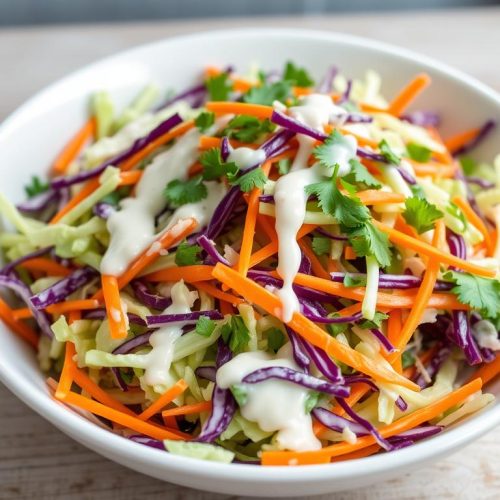I love a good balanced diet. I’m excited to share a 7-day meal plan that’s both healthy and tasty. It’s perfect for keeping up with a busy life while still eating well.
This plan offers lots of healthy, filling meals. It’s great for anyone wanting to eat better, feel more energetic, or just enjoy tasty food. You’ll find it easy to stick to.
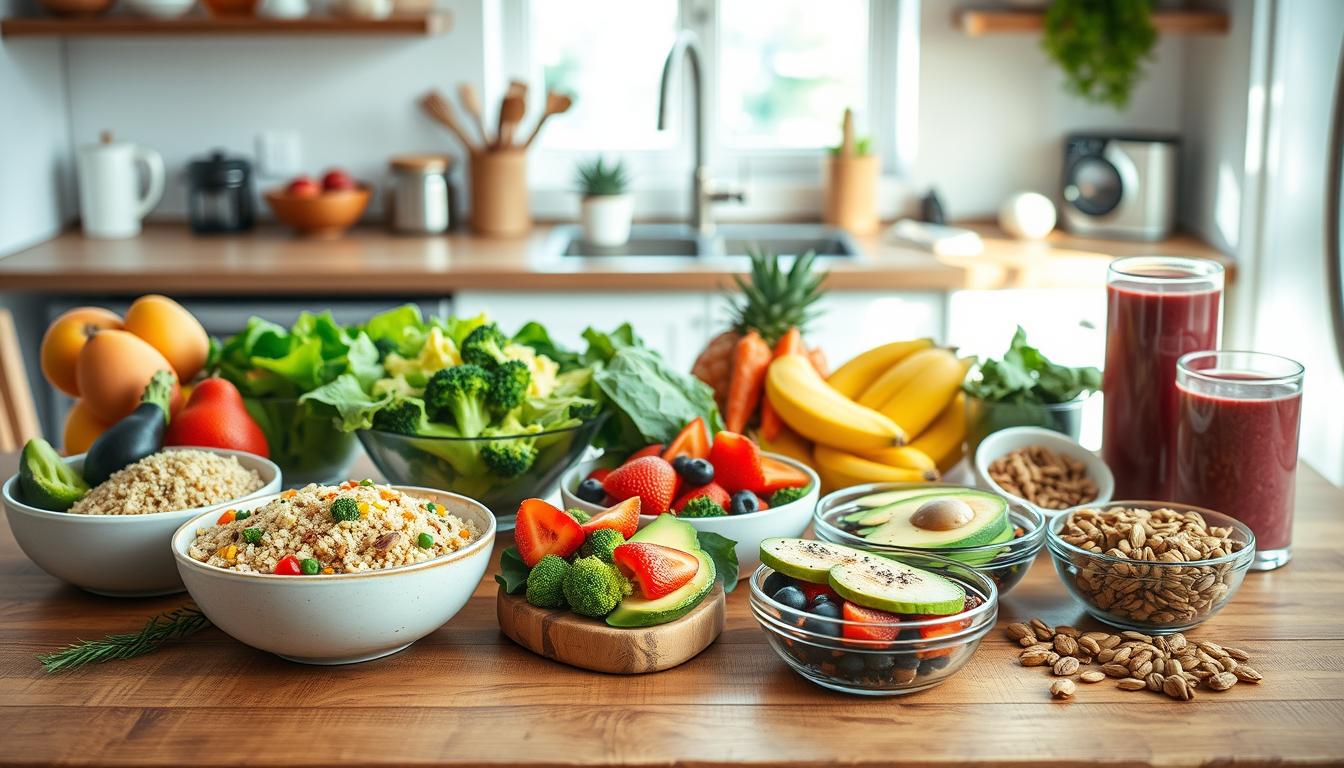 alt=”Healthy Meal Plan” data-id=”133110396″ />
alt=”Healthy Meal Plan” data-id=”133110396″ />
Key Takeaways
- 7-day healthy meal plan for balanced nutrition
- Variety of wholesome, nutrient-dense meals
- Designed to support wellness goals and energy levels
- Easy to incorporate into a busy lifestyle
- Emphasis on delicious, satisfying food
Understanding the Basics of Balanced Nutrition
Eating well is key to feeling good. A good healthy diet gives your body what it needs every day. Knowing about macronutrients and portion sizes helps make a diet that lasts.
Essential Nutrients Your Body Needs Daily
A good diet has many essential nutrients. These include:
- Carbohydrates for energy
- Proteins for muscle growth and repair
- Healthy fats for hormone production and brain function
- Vitamins and minerals for the immune system, bone health, and more
The Role of Macronutrients in Your Diet
Macronutrients like carbs, proteins, and fats give you calories. Eating the right mix is key for balanced nutrition and energy.
Importance of Portion Control
How much you eat matters a lot. Eating the right amount helps avoid too much weight and health problems. Watch your serving sizes and listen to your body to keep a healthy diet.
“The key to a balanced diet is to consume the right amounts of each essential nutrient, not just to focus on one or two.”
How to Get Started with a Healthy Meal Plan
Starting a healthy meal plan might seem hard. But, it can be easy and fun with the right steps. Begin small, set easy goals, and build a meal plan that fits you. Here’s how to start:
- Assess Your Current Eating Habits: Look at what you eat, how often you snack, and how much you eat. This helps you see what to change.
- Determine Your Nutritional Needs: Think about your age, how active you are, and any health issues. Talk to a dietitian to learn what nutrients you need.
- Set Realistic Goals: Know what you want from your meal plan. Do you want to lose weight, feel more energetic, or manage a health problem? Make your goal clear and reachable.
- Explore Meal Prep Strategies: Spend a few hours each week on meal prep. Look for recipes, get the right kitchen tools, and make a shopping list. This makes meal prep easier.
- Embrace Flexibility: A healthy meal plan is not the same for everyone. Try new recipes, adjust how much you eat, and find what works for you.
By following these steps, you’re on your way to a meal plan, healthy meal prep, and diet meal plans that help your health. Keep going, celebrate your wins, and enjoy the journey to a healthier life.
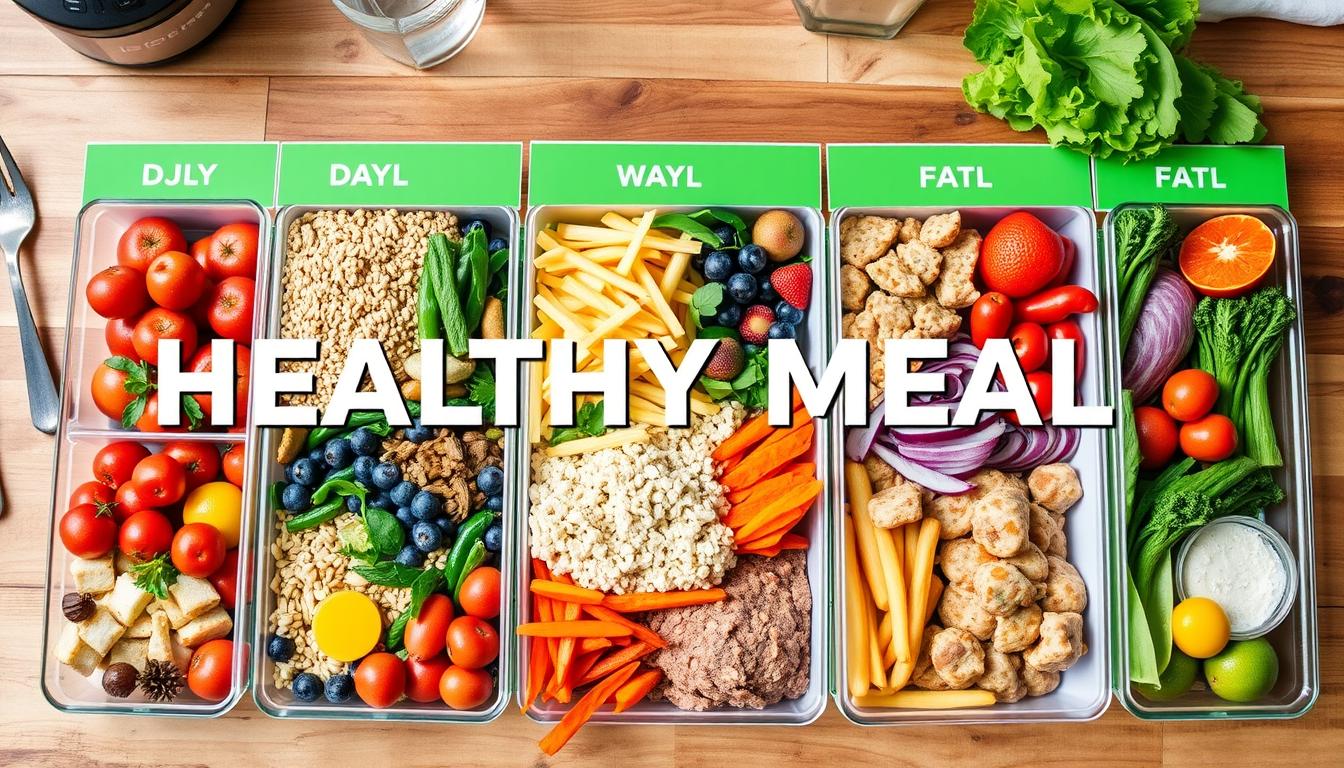 alt=”meal plan” data-id=”133110398″ />
alt=”meal plan” data-id=”133110398″ />
“The key to a successful meal plan is to find a balance between nutrition, taste, and convenience. With a little planning and preparation, you can create a healthy eating routine that becomes a natural part of your lifestyle.”
Smart Shopping Guide for Your Weekly Meal Prep
Healthy meals at home change your nutrition. It starts with smart shopping. Make a good shopping list, pick the best ingredients, and stay within your budget. Let’s look at how to make your meal prep easier.
Creating an Efficient Shopping List
A good grocery list is key for meal prep. First, look at your meal plan and see what you already have. This helps you know what to buy. Organize your list by type, like fruits, meats, and pantry items, to make shopping easier.
Choosing Fresh vs. Frozen Ingredients
Choosing between fresh and frozen is important. Fresh is great for taste and nutrients, but frozen is cheaper and lasts longer. Mix both to make healthy meals.
Budget-Friendly Shopping Tips
Eating healthy doesn’t have to cost a lot. Here are tips to save money:
- Buy in-season produce for less
- Look at unit prices for the best deals
- Choose store-brand items for pantry staples
- Use sales, coupons, and loyalty programs
- Meal prep in batches to save food and ingredients
Follow these tips for a healthy meal prep that’s easy on your wallet. Enjoy your journey to better nutrition!
Kitchen Tools and Equipment for Successful Meal Planning
I love cooking at home. The right tools make it easier. From containers to cookware, they help me cook and eat healthily.
I bought BPA-free meal prep containers. They help me pack meals in advance. I can store everything from chicken to salads in them.
A good set of knives is key. Sharp knives make chopping easy. I use a chef’s knife, paring knife, and serrated knife the most.
- Meal prep containers
- High-quality knives (chef’s knife, paring knife, serrated knife)
- Slow cooker or Instant Pot for hands-off cooking
- Blender or food processor for smoothies, purees, and more
- Sheet pans and baking dishes for roasting and baking
A slow cooker or Instant Pot changed my cooking. They make healthy meals easy. A blender or food processor is great for smoothies and sauces.
Sheet pans and baking dishes are also essential. They help me roast and bake with less cleanup.
These meal prep tools, kitchen equipment, and healthy cooking essentials help me plan meals better. Now, I can enjoy healthy meals all week.
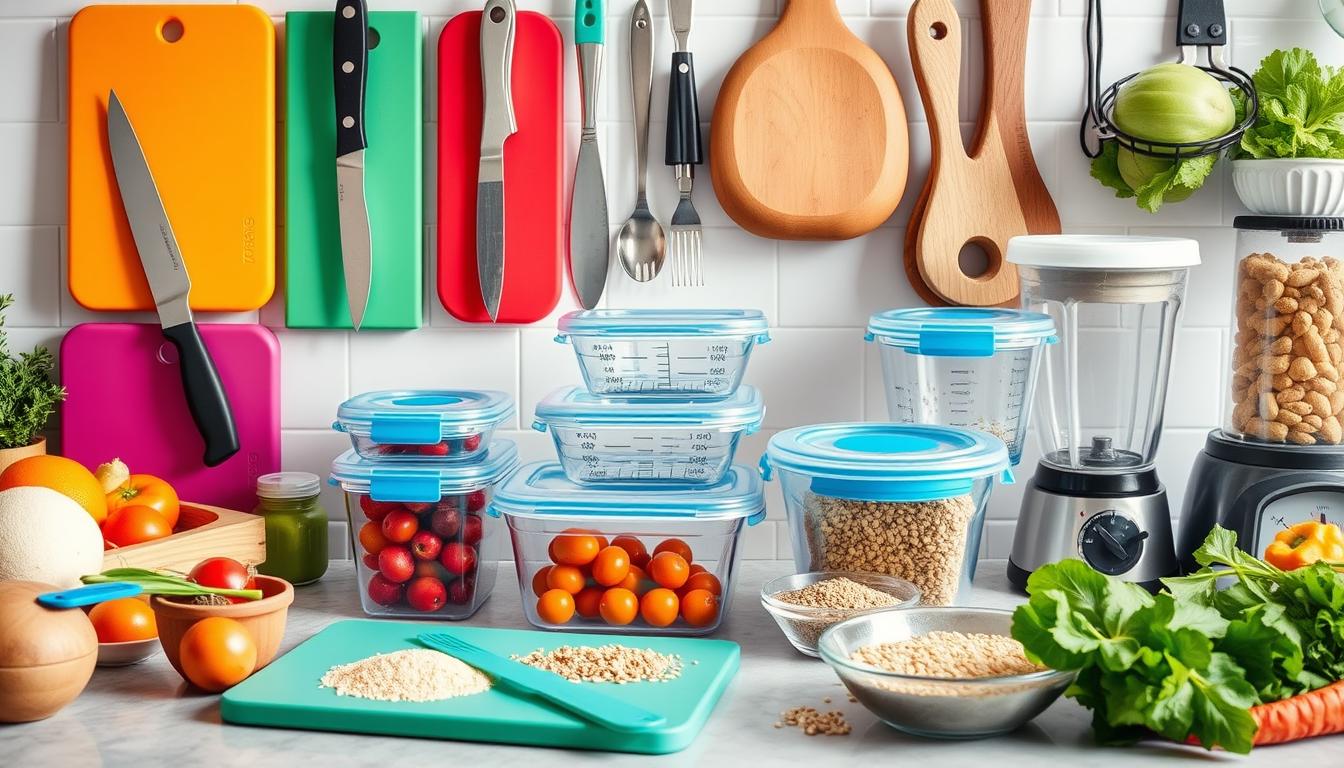 alt=”meal prep tools” data-id=”133110400″ />
alt=”meal prep tools” data-id=”133110400″ />
Breakfast Options for a Nutritious Start
Starting your day with a healthy breakfast is key. It keeps you energized and focused. There are many tasty and healthy choices to start your day.
Quick and Easy Morning Meals
When you’re short on time, try simple breakfasts. Overnight oats, avocado toast, or a hard-boiled egg are great. These healthy breakfast ideas are quick and nutritious.
Make-Ahead Breakfast Ideas
Plan for a stress-free morning. Make healthy muffins, breakfast burritos, or yogurt parfaits on the weekend. These low calorie meal options are ready to go all week.
Power-Packed Smoothie Recipes
Smoothies are a great way to start your day. Mix your favorite fruits and veggies with protein like Greek yogurt or nut butter. This healthy breakfast will keep you energized.
| Breakfast Option | Nutrition Profile | Preparation Time |
|---|---|---|
| Overnight Oats | High in fiber, complex carbs, and protein | 5-10 minutes (plus overnight chilling) |
| Avocado Toast | Rich in healthy fats, vitamins, and minerals | 5 minutes |
| Breakfast Burrito | Protein-packed with eggs, beans, and veggies | 30 minutes (for batch preparation) |
| Smoothie | Loaded with vitamins, minerals, and antioxidants | 5-10 minutes |
Choosing any healthy breakfast is a great start. You’ll fuel your body with what it needs to do well.
Lunch Ideas That Keep You Energized
Getting a good lunch is key to staying energetic all day. You can prep meals at home or find quick options. There are many healthy lunch ideas to keep your body fueled.
One great low-calorie meal prep tip is to use lean protein like grilled chicken or tofu. Add fresh veggies, quinoa or brown rice, and avocado or nuts. This mix keeps your blood sugar steady and gives you energy for the afternoon.
- Grilled salmon with roasted sweet potatoes and steamed broccoli
- Turkey and veggie wraps with hummus and whole-grain tortillas
- Lentil and vegetable soup with a side salad and whole-grain crackers
When you’re in a rush, grab nutritious options like Greek yogurt with berries, hard-boiled eggs, or nuts. These healthy lunch ideas are easy to pack and keep you focused and full of energy.
“Eating a balanced lunch is essential for maintaining steady energy levels and mental clarity throughout the day.”
Plan your meals and include healthy lunch ideas in your meal prep. This way, you fuel your body for success all week.
 alt=”healthy lunch ideas” data-id=”133110402″ />
alt=”healthy lunch ideas” data-id=”133110402″ />
Healthy Dinner Recipes for the Entire Week
Making a healthy dinner is rewarding. You can follow a heart-healthy diet or just want to eat better. There are many tasty options to try.
From plant-based meals to lean proteins, the goal is to eat well and live busy. Find meals that are good for you and easy to make.
Plant-Based Dinner Options
Plant-based dinners are tasty and heart-friendly. Try roasted vegetable quinoa bowls or lentil and sweet potato curry. A bean and brown rice burrito bowl is also great.
These healthy dinner recipes are full of fiber and vitamins. They make you feel good.
Lean Protein Combinations
Lean proteins make meals balanced. Grilled salmon with asparagus or pan-seared chicken with greens are good. Stir-fries with tofu and veggies also work well.
These heart-healthy diet plan options give you energy. They’re perfect for a healthy dinner.
30-Minute Dinner Solutions
Quick meals are a must for busy days. Try stuffed sweet potatoes or zucchini noodle pasta with shrimp. A quinoa and veggie stir-fry is also quick.
These quick meals are ready in 30 minutes. They’re great for weeknights when time is short.
Adding different healthy dinner recipes to your week is smart. You can enjoy tasty, healthy meals. Whether you like plant-based or lean protein, there’s something for everyone.
Smart Snacking Between Meals
Healthy eating doesn’t mean no snacks. Smart snacking keeps your energy up and cravings away. Choose low-calorie, nutritious snacks that fit your meal plan.
There are many tasty healthy snacks. For sweet lovers, try Greek yogurt with berries or dark chocolate almonds. For savory fans, enjoy veggie sticks with hummus or a low-fat cheese stick with whole-grain crackers.
Make sure your snacks are small and low in calories. Prepare snacks like nuts or fruit slices ahead of time. This makes it easy to grab a healthy snack when you’re hungry.
| Healthy Snack | Calories | Nutritional Benefits |
|---|---|---|
| Apple slices with almond butter | 200 calories | High in fiber, protein, and healthy fats |
| Cucumber slices with tzatziki dip | 150 calories | Hydrating, low in calories, and high in vitamins |
| Roasted chickpeas | 170 calories | Good source of protein, fiber, and complex carbohydrates |
Smart snacking is about finding the right balance. It satisfies your cravings and supports your nutrition goals. By eating a variety of healthy snacks, you stay energized all day.
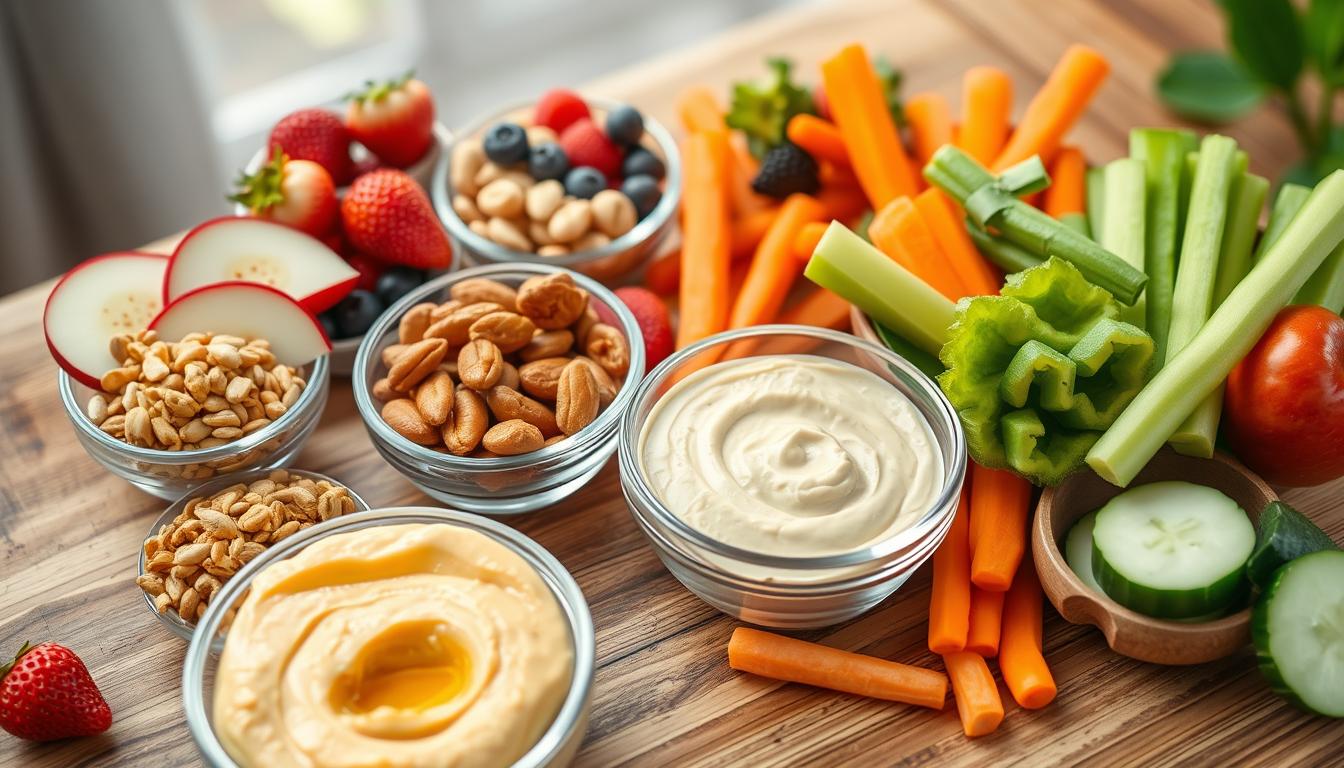 alt=”healthy snacks” data-id=”133110404″ />
alt=”healthy snacks” data-id=”133110404″ />
Meal Prep Strategies for Busy Professionals
As a busy professional, finding time for healthy meals can be hard. But, with the right meal prep strategies, you can save time and eat well. Let’s look at some ways to make your meal prep easier.
Time-Saving Preparation Techniques
Maximizing efficiency is key to good meal prep. Here are some tips:
- Batch cooking: Cook big batches of your favorite dishes. Then, store them in containers for quick meals all week.
- Meal prepping on the weekends: Spend a few hours on the weekend chopping veggies, cooking grains, and making meals. This saves a lot of time during the week.
- Embracing simple recipes: Choose easy, one-pot meals like stir-fries or sheet-pan dishes. They need a little prep and clean up.
Storage Solutions and Food Safety
Storing food right and keeping it safe is important. Here are some tips:
- Use airtight containers: Get good, BPA-free containers. They keep your food fresh and safe from contamination.
- Rotate your meals: Eat the oldest meals first. This keeps your food safe and reduces waste.
- Freeze for later: Freeze your meals in portions. This keeps them fresh longer and gives you healthy options when you’re busy.
Batch Cooking Guidelines
Batch cooking saves time and money. Here are some guidelines:
| Ingredient | Batch Cooking Quantity |
|---|---|
| Grains (rice, quinoa, etc.) | 2-3 cups dry |
| Protein (chicken, tofu, lentils) | 1-2 pounds |
| Vegetables | 4-6 cups chopped |
By using these strategies, you can make your meal prep easier. You’ll save time and have healthy meals ready for the week.
Adapting the Meal Plan for Special Dietary Needs
Personalized meal plans are very important. They help people with special diets get the right nutrition. If you eat vegetarian, vegan, gluten-free, or low-sodium, you can still enjoy tasty meals.
To fit your special diets, change the protein sources. For vegetarians or vegans, use tofu, tempeh, lentils, or chickpeas instead of meat and dairy. If you can’t eat gluten, try quinoa, rice, or gluten-free oats. For low-sodium diets, use fresh herbs and spices to add flavor without salt.
Meal prepping can also be changed for your dietary restrictions. Cook big batches of veggie stir-fries, roasted veggie bowls, or bean soups. These can be divided and eaten all week, making healthy eating easy.
“Customizing your meal plan is the key to maintaining a balanced diet that aligns with your unique nutritional needs.”
A personalized meal plan is not for everyone. Try new recipes and ingredients to find what you like. With a bit of creativity, you can make healthy, tasty meals that are good for you.
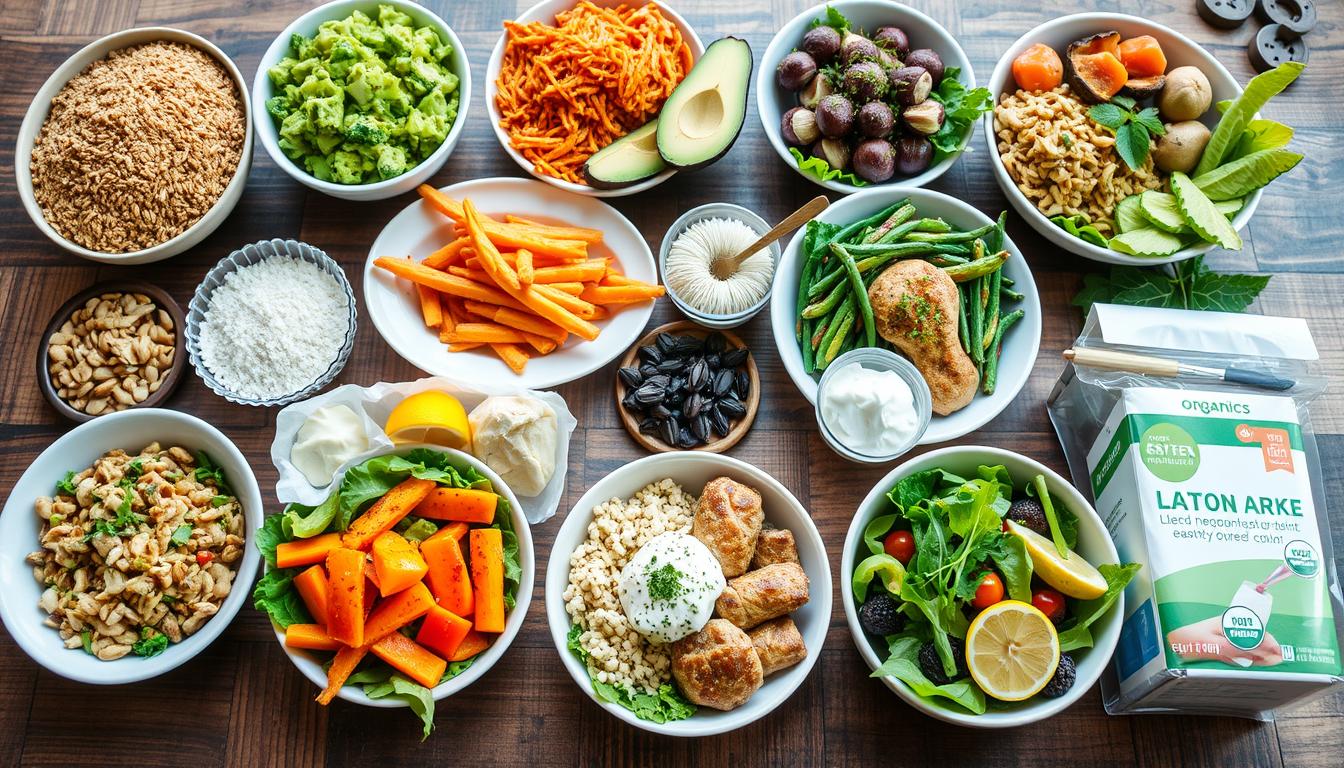 alt=”special diets” data-id=”133110406″ />
alt=”special diets” data-id=”133110406″ />
Conclusion
We’ve looked at a 7-day healthy meal plan. I hope you now see how important balanced nutrition is. The right mix of nutrients helps our bodies stay healthy.
Small changes in what we eat can make a big difference. Try the tasty recipes and meal prep tips. Make the plan fit your needs. With effort, it can be a big part of your life.
Everyone’s path to good nutrition is different. But the basics we’ve talked about are a good start. I wish you luck in following this meal plan. May it lead you to a healthier, happier life.
FAQ
What is a 7-day healthy meal plan?
A 7-day healthy meal plan gives you balanced nutrition for a week. It offers many tasty and healthy meals. This helps you reach your wellness goals and enjoy good food.
Why is a balanced nutrition plan important?
Having a balanced nutrition plan is key for health. It makes sure your body gets all the nutrients it needs. This boosts energy and supports your health for the long term.
How do I get started with a healthy meal plan?
To start a healthy meal plan, set realistic goals and know your dietary needs. Make a plan that suits your life. This might mean planning meals, making shopping lists, and using lots of healthy ingredients.
What are some tips for smart grocery shopping?
For smart grocery shopping, make a good shopping list. Choose fresh and frozen foods. Look for affordable healthy options. Buying whole foods helps you make better choices.
What kitchen tools are essential for meal planning?
Key kitchen tools for meal planning are meal prep containers and a blender for smoothies. A slow cooker or Instant Pot is great for easy cooking. Also, use airtight containers to keep food fresh.
What are some healthy breakfast options?
Healthy breakfasts include overnight oats, smoothies, and breakfast burritos or frittatas. These meals give you a good start and energy for the day.
What are some ideas for healthy lunches?
Healthy lunches are salads, whole grain bowls with protein, and portable meals like mason jar salads. These meals give you energy all day.
What are some healthy dinner recipes for the week?
Healthy dinner recipes include plant-based meals, lean protein, and quick meals. These dishes are balanced and fit different diets. They’re easy to add to your week.
What are some healthy snacking ideas?
Good snacks are fresh fruit, veggie sticks with hummus, and Greek yogurt with berries. Roasted nuts or seeds are also great. These snacks are full of nutrients and satisfy hunger.
How can I adapt the meal plan for special dietary needs?
To adjust the meal plan for special diets, like vegetarian or gluten-free, I can suggest changes. This makes sure the plan fits your needs and is inclusive.



